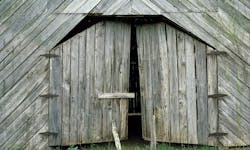Wood: Reclaim, Reuse, Repeat
The information in this article was updated in February 2019.
Hardwood competes with few other building and finish materials in its natural look and feel, its elegance (or rusticity), its design flexibility and the way it resonates with home buyers. Increasingly, buyers and builders seek out reclaimed wood, used lumber "harvested" from old homes, factories, warehouses, barns, wineries, breweries and even bridges and railroads.
Reclaimed old-growth shows its age, and that’s why people love it. It is seasoned, generally denser and stronger, and age and a long history of use give it a patina that can’t be replicated. Builder Ron Jones in New Mexico speaks reverently of the 24-foot-long, 12x12-inch beams saved in the demolition of a century-old railroad trestle that ran across a bay of Great Salt Lake. "The salt impregnated them, leaving them with an iridescent glow that shows in the light. When we were cutting those timbers and working on the corbels, you could actually smell and taste the salt in the air. Incredible." A popular choice for flooring, reclaimed wood can be used in the same applications as new wood, including paneling, millwork, beams, timbers, cabinetry and built-ins, stairs, handrails, mantels and exterior siding. Expect it to have scars, oxide and other stains, nail holes and other character marks because it brings the story of its former life with it—and often that story cinches the deal with custom home builders and buyers. Mountain Lumber, in Ruckersville, Va., sells European Cooper’s Oak floors made from wood that stored beer in the original Guinness brewery in Dublin, Ireland. TerraMai, in McCloud, Calif., recently acquired the last of the 80-year-old, 20-foot-high by 20-foot-diameter redwood wine tanks from the Sebastiani vineyard in Sonoma, Calif.Salvaged wood—wood that hasn't been used before—such as old forest growth and logs found in rivers or other waterways used to transport logs is often hundreds of years old and perfectly preserved in the water because it's safe from oxygen and heat, conditions that cause wood to degrade.
Reclaimed and salvaged woods’ attractiveness increases for some when one considers sustainability—the more old wood saved from landfill and reused, the fewer trees get cut down—although energy expended in harvesting, finishing, and transportation may somewhat diminish those benefits. Reclaimed and salvaged wood is hardly an entry-level production product; price being the biggest hurdle to its more widespread use, followed by availability and transportation.
Where to Get It
Good places to start are reusewood.org, smartwood.org, and forestethics.org. While not comprehensive, these sites combined list more than 50 purveyors of reclaimed wood and reclaimed wood products for use in residential buildings.

